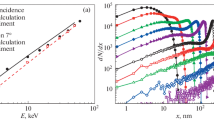Abstract
We have obtained the range distributions for H, D, and He atoms within an energy range of 0.1–100 keV in amorphous W and Si for the normal incidence of bombarding particles. Calculations have been performed both in the binary collision approximation and by a more accurate method of calculating particle trajectories. It is shown that the results of both methods are in good agreement with each other and with experimental data on the mean ranges for the H–Si system. The influence of the attracting well in the particle–solid interaction potential on the results of calculations is estimated.







Similar content being viewed by others
REFERENCES
V. M. Kivilis, E. S. Parilis, and N. Yu. Turaev, Dokl. Akad. Nauk 173, 805 (1967).
V. E. Yurasova, V. I. Shulga, and D. S. Karpuzov, Can. J. Phys. 46, 759 (1968). https://doi.org/10.1139/p68-094
E. S. Mashkova and V. A. Molchanov, The Use of Ion Scattering in Solids Analysis (Energoatomizdat, Moscow, 1995).
W. Eckstein, Computer Simulation of Ion–Solid Interactions (Springer, 1991).
http://www.srim.org.
M. T. Robinson and I. M. Torrens, Phys. Rev. B 9, 5008 (1974). https://doi.org/10.1103/PhysRevB.9.5008
P. Y. Babenko, A. N. Zinoviev, D. S. Meluzova, and A. P. Shergin, J. Surf. Invest.: X-Ray, Synchrotron Neutron Tech. 12, 520 (2018). https://doi.org/10.1134/S1027451018030230
P. Yu. Babenko, A. M. Deviatkov, D. S. Meluzova, A. P. Shergin, A. N. Zinoviev, Nucl. Instrum. Methods Phys. Res., Sect. B 406, 538 (2017). https://doi.org/10.1016/j.nimb.2016.12.043
https://www-nds.iaea.org/stopping.
L. Verlet, Phys. Rev. 159, 98 (1967). https://doi.org/10.1103/PhysRev.159.98
E. Ligeon and A. Guivarc’h, Radiat. Eff. 27, 129 (1976). https://doi.org/10.1080/00337577608243025
M. Weiser, M. Behar, S. Kalbitzer, P. Oberschachtsiek, D. Fink, and G. Frech, Nucl. Instrum. Methods Phys. Res., Sect. B 29, 587 (1987). https://doi.org/10.1016/0168-583X(87)90073-5
A. N. Zinoviev, Nucl. Instrum. Methods Phys. Res., Sect. B 269, 829 (2011). https://doi.org/10.1016/j.nimb.2010.11.074
B. P. Nikol’skii, Chemistry Handbook (Khimiya, Moscow, 1966), Vol. 1.
A. N. Zinoviev and K. Norlund, Nucl. Instrum. Methods Phys. Res., Sect. B 406, 511 (2017). https://doi.org/10.1016/j.nimb.2017.03.047
J. F. Ziegler, J. P. Biersack, and U. Littmark, The Stopping and Range of Ions in Solids (Pergamon, New York, 1985).
Funding
This study was performed under a State assignment of the Ministry of Education and Science of the Russian Federation for the Federal State Budget Scientific Enterprise Ioffe Institute, Russian Academy of Sciences.
Author information
Authors and Affiliations
Corresponding author
Ethics declarations
The authors claim that there are no conflicts of interest.
Additional information
Translated by N. Wadhwa
Rights and permissions
About this article
Cite this article
Meluzova, D.S., Babenko, P.Y., Shergin, A.P. et al. Ranges of Hydrogen, Deuterium, and Helium Atoms in Amorphous Silicon and Tungsten. Tech. Phys. 65, 145–150 (2020). https://doi.org/10.1134/S106378422001017X
Received:
Revised:
Accepted:
Published:
Issue Date:
DOI: https://doi.org/10.1134/S106378422001017X




